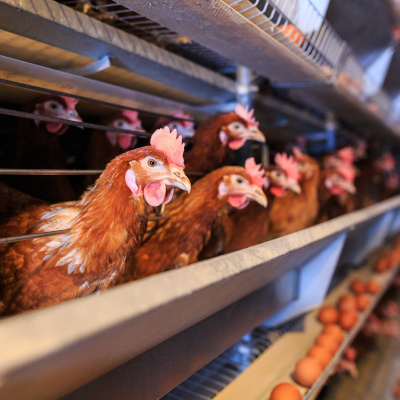H5N1 Bird Flu

Background
Avian Influenza (H5N1), also known as H5 bird flu, is a viral infection known to be highly contagious and often deadly among wild birds. Recently, this virus has caused outbreaks in other animals such as poultry and dairy cows.
People rarely get bird flu. When they do, it's usually due to close contact with sick animals. The current risk of H5 bird flu infection for the public is low. People at higher risk of infection are those who work closely with animals that could be sick, such as farmworkers, backyard flock owners, and veterinarians.
At this time, there is no evidence of person-to-person spread of H5 bird flu in the United States, but public health officials are monitoring the situation closely. Influenza A viruses like bird flu found in one species have been known to develop the ability to cause disease in other species as well. General information about H5 bird flu is available from the Centers for Disease Control and Prevention along with a summary of the current situation.
- H5 bird flu can spread via the mucous, saliva, dander, and feces (poop) of infected birds, or through body fluids (e.g., milk) of other infected animals.
- People can become infected when the H5N1 virus gets into a person’s, eyes, nose, or mouth, or is breathed in during direct contact or proximity to an infected animal or contaminated environment.
- Symptoms in people usually begin 2 to 7 days after exposure to the virus.
- Most people in the U.S. who have developed H5 bird flu have had mild symptoms, and some people may not have any symptoms. However, several severe infections have occurred, including at least one death.
- Eye redness and irritation (conjunctivitis) has been the most common symptom reported.
- Other mild symptoms can be similar to seasonal flu, including fever, cough, stuffy nose, sore throat, muscle/body aches, headache, and fatigue.
- Severe disease can cause difficulty breathing, altered consciousness, or seizures. Complications of H5N1 infection can include pneumonia, multi-organ failure, sepsis, inflammation of the brain, and death.
- The best way to prevent H5N1 infection is to avoid contact with and exposure to sick or dead wild birds or other animals. Do not touch surfaces that might be contaminated with the saliva, mucous, or poop from these animals.
- Report instances of five or more deceased birds found in one location to the local Illinois Department of Natural Resources wildlife biologist or USDA Wildlife Services at 1-866-487-3297. Report sick or dead domestic poultry to the Illinois Department of Agriculture.
- If you must have direct contact with sick birds or other animals, wear personal protective equipment (PPE), including: N95 mask, safety goggles, gloves, boots, head cover, and fluid-resistant clothing.
- Do not eat or drink raw milk or raw milk products, especially from animals that have been exposed to other infected species and could be sick with H5N1 virus.
- Cook poultry, eggs, and beef to a safe internal temperature to kill bacteria and viruses, and do not eat undercooked meat products.
- Do not feed raw milk products or undercooked meats to your pets.
- Keep pets away from other sick animals, as this can create conditions for the virus to spread between species. Prevent wild birds from interacting with poultry and other farm or backyard animals.
- If you think you might be sick with H5 bird flu, talk to your healthcare provider about what symptoms you are having and any exposures you have had to animals or animal products.
Frequently Asked Questions
Bird flu is a type of novel influenza A virus, or an influenza virus distinct from the flu humans get vaccinated for seasonally—also known as “seasonal flu”. Bird flu (H5N1) virus is not new and is widespread among wild birds. Recently, the virus has caused outbreaks in poultry, such as chickens and turkeys, and in dairy cows. The risk of bird flu infection to the public is low, but people who work directly with sick or dying birds or other animals are at a higher risk of infection.
Many different types of animals can get bird flu. Some birds that can be affected include chickens, turkeys, wild shorebirds like gulls or storks, waterfowl such as ducks, geese, and swans, and birds of prey like owls, eagles, or hawks. Some other domestic animals that can be affected include cats, pigs, goats, and dairy cows. Wild animals that can be affected include seals, fox, tigers, and lions.
Most people infected with bird flu in the United States have had mild symptoms, with eye redness and irritation being the most common. Symptoms can start about 2–7 days after exposure to sick or dead birds. Other symptoms may include fever or feeling feverish, cough, sore throat, runny nose, muscle or body aches, headache, and fatigue. In rare cases, people can develop severe disease or complications due to bird flu including a high fever, difficulty breathing, altered consciousness, seizures, and death.
Signs of bird flu in animals differ depending on the type of animal. In chickens and turkeys, the symptoms can be sudden death, low energy or appetite, nasal discharge, coughing or sneezing, lack of coordination, diarrhea, purple discoloration around the eyes, increased effort to breathe, changes in coordination or difficulty walking, and decreased egg production. In cats or dogs, signs can include severe depression, eye and nasal discharge, sneezing, coughing, trouble breathing, and neurologic signs like difficulty walking, circling, seizures, or blindness. Cats are more severely affected than dogs. In dairy cattle, signs can include low appetite, decreased milk production, or thickened milk.
In March 2024, an outbreak of H5N1 in dairy cows occurred across multiple states. This was the first time that this virus was found in cattle as opposed to its usual bird species host. In April 2024, the first instance of H5N1 spread from a dairy cow to a human was identified. Since that time, there have been multiple human cases of H5 bird flu in the US, including one death. While the risk to the public remains low, it is possible that the bird flu virus could mutate and spread more easily between humans. Public health officials are monitoring the situation closely.
The best way to prevent bird flu is to avoid contact with sick or dead wild birds, poultry, or other animals and any surfaces that could be contaminated with their saliva, mucous, or poop. If you must have contact with sick or dying animals, wear recommended personal protective equipment, including an N95 mask, disposable gloves, safety goggles, fluid-resistant clothing, boots, and a head or hair cover. You should also wash your hands both before and after handling sick and dead animals.
Pets can be exposed to bird flu by eating or contacting sick or dying wild birds or intermingling in a contaminated environment. They can also become infected by drinking raw milk from infected cows, raw eggs, or eating undercooked or raw meat. Although it’s unlikely that dogs will become infected, several cats have become severely ill with bird flu. To prevent pets from becoming sick, keep cats indoors and do not allow dogs or cats to have contact with birds or other wildlife. Thoroughly cook raw meat before feeding it to your pet, and do not feed them raw milk. If your pet develops signs of bird flu, contact your veterinarian immediately and discuss your pet’s symptoms with them before bringing them into the clinic.
While bird flu is circulating, do not attempt to pick up or handle a sick or dying bird. If you must contact sick or dying birds, such as in the case of a bird die-off on your property, do not use bare hands to contact the animals. Wear personal protective equipment (PPE) including disposable gloves, safety goggles, and an N95 mask. Use disposable gloves or an inverted plastic bag to pick up dead birds, double the plastic bag, and discard the bird in a garbage can that cannot be accessed by children or other animals. Discard disposable PPE after use and disinfect multi-use equipment and clothing. Please do not attempt to capture wild birds displaying symptoms of bird flu or bring these birds into a veterinary clinic or wildlife center. If you develop flu-like symptoms within 10 days after making contact with a sick or dying bird, you should contact your healthcare provider and tell them about your symptoms and your exposure to sick birds.
Symptoms of bird flu are similar to other respiratory illnesses, such as seasonal flu or COVID-19, and may include fever, cough, sore throat, eye redness or irritation, stuffy nose, and head or body aches. Most people with bird flu have had close contact with sick or dying birds or other animals. If you think your symptoms could be due to bird flu, please contact a healthcare provider to discuss your symptoms and potential exposure. Stay home and limit contact with others as much as possible. If you need to interact with people in or outside of your home, wear a well-fitted face mask. If you need medical care, call the healthcare facility before going to let them know that you are concerned about bird flu.
Medications used to treat seasonal flu (also known as antivirals), like oseltamivir, can treat bird flu infections in people. People who are known or suspected to have an H5 bird flu infection should receive treatment with flu antivirals as soon as possible. Antiviral treatment works best within 48 hours of developing symptoms and should not be delayed while waiting for testing results.
Poultry owners can protect their flock by cleaning enclosures and poultry equipment to remove feces (poop) and infected body fluids that can help spread the virus between birds. Limiting human visitors to your flocks, especially those with recent contact with other birds or poultry of their own, can also prevent spread between flocks. Be sure to ask visitors to wash their hands with soap and water before and after bird handling, wear clean clothes, and wear clean and washable footwear when interacting with your flock. Enclose poultry living and feeding areas to prevent contact with wild birds, livestock, or household pets. Consider also removing bird feeders to limit contact with wild birds. New or sick birds should be separated from the rest of the flock for 30 days prior to re-introduction to prevent further spread of the virus among birds in the same enclosure.
The Chicago Department of Public Health (CDPH) is closely monitoring bird flu, and the risk it poses to people. CDPH is helping to expand H5N1 testing options for providers in the community. For Chicagoans who know they have been exposed to bird flu, CDPH monitors their health for 10 days after their exposure. If they develop symptoms of bird flu during that time, CDPH will make sure they can be seen safely by a health care provider and receive any needed treatment and testing.
The United States Department of Agriculture does not recommend removing backyard feeders unless you also have poultry, such as a backyard flock. If you care for poultry, you should prevent any contact between wild birds and poultry.
Yes. There is no evidence that bird flu can be transmitted to humans through poultry products when they are properly prepared. To ensure proper preparation, cook poultry and eggs to 165°F, a temperature that can kill viruses and bacteria. Cooked poultry should not appear pink. Pasteurized milk is safe to drink, but raw or unpasteurized milk should be avoided for both humans and pets.
The seasonal flu vaccine will not prevent infection with bird flu viruses, but it can reduce the risk of getting sick with the “seasonal flu.” It can also prevent people from getting sick with both seasonal flu and bird flu at the same time—a situation which can increase the opportunity for bird flu to mutate.




